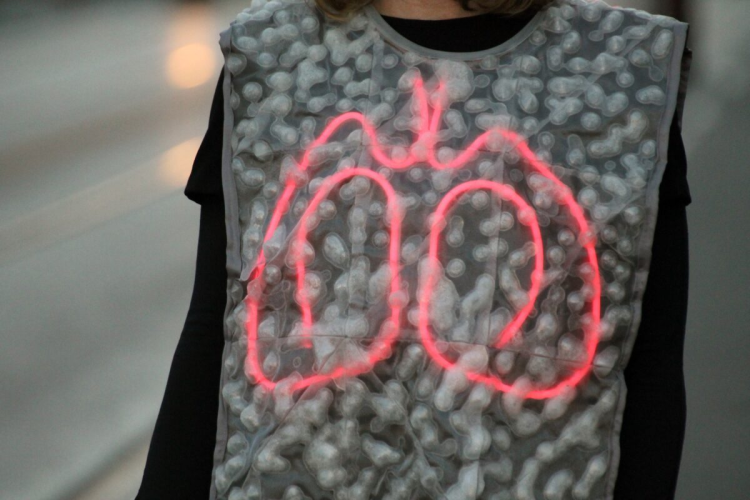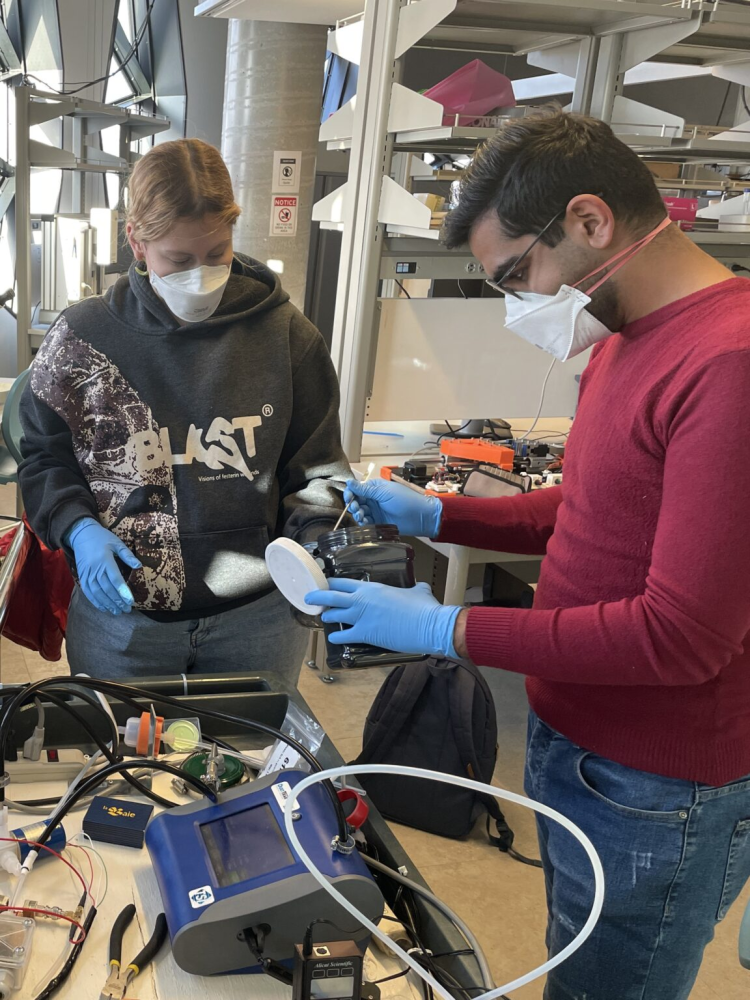York University researchers are working to make invisible air pollution visible through an innovative project that merges art, science and engineering.
Focusing on the threats of airborne black carbon - a pollutant resulting from vehicle exhaust and wildfire smoke - the team will create wearable technology that detects these harmful emissions in real time.

My Air Wear prototype, depicting how the black carbon particulate will be visible when wearing the vest
With the World Health Organization reporting an estimated 4.2 million premature deaths each year caused by ambient air pollution, the "SensingChange: Black carbon air pollution detection and critical artworks" project aims to develop a novel measurement tool and increase public awareness.
"The main idea is to try to tackle the global threat of climate change," explains Grace Grothaus, a York PhD student and computational media artist. "A lot of attention goes to carbon dioxide and methane emissions, but black carbon emissions are a major contributor to climate change and a main driver of immediate health threats."
The interdisciplinary project sees collaboration between scholars and students in the Lassonde School of Engineering - including graduate student Abolfazl Kohenstani and undergraduate Basak Babadagi - and other researchers in the School of the Arts, Media, Performance & Design - such as principal investigator Professor Mark-David Hosale. The group's aim is to develop a sensor to isolate and measure black carbon particulates. This sensor will be integrated into electronics that Grothaus will create for smart garments called "My Air Wear," designed in collaboration with an industrial design lab out of the Ontario College of Art & Design (OCAD). When worn, My Air Wear will light up in response to black carbon emissions, giving a visual indication of how much of the pollutant is in the air.
"We are engineers, atmospheric scientists, artists and designers," says Grothaus, who is also leading the project's public art, awareness and outreach initiatives.
Gerd Grau is an associate professor of electrical engineering at York. His lab, through Lassonde, uses novel materials and additive manufacturing techniques to develop devices such as transistors, sensors and more.
To design this low-cost, low-waste sensor, his team employed a laser process to convert a polymer into a form of graphene - an electrically conductive material.

York grad student and research assistant Abolfazl Anvari with undergraduate student and research assistant Basak Babadagi working on the project.
"We've created a prototype and we are currently characterizing it in terms of its sensitivity to black carbon," he says, adding much of the time in this development stage has been spent calibrating the sensor's measurement capabilities.
The researchers aim to make the sensors sensitive enough to show real-time responses as vehicles pass by, making the invisible pollution immediately apparent to wearers and observers.
Current particulate sensors don't isolate this specific type of pollution, earning the project a $248,428 Exploration Grant from the Government of Canada's New Frontiers in Research Fund (NFRF), which funds high-risk, high-reward and interdisciplinary research.
Once the sensors and vests are ready to deploy, the team will call on the public to collect information about black carbon levels in their neighbourhoods. The team plans to engage 10 to 50 citizen scientists in the initial phase, who will collect real-time, location-specific pollution data while wearing the vests and upload findings to the online database.
The project also has a significant artistic component. The team plans to create more elaborate wearable artworks, "AtmoSpheres," which use motifs such as illuminated lungs to show emissions from passing cars to showcase at parades and exhibitions. There are also plans to seek out collaborations with art galleries. These public initiatives aim to raise awareness about black carbon emissions and their impact on health and the environment.
This fall, the team will launch community workshops to share prototypes, get feedback and iterate in design cycles. The larger community initiatives will launch later, possibly next spring.
"We are trying to create a kit that will enable small groups of people to participate," says Grothaus. "If it works here in Toronto, then we can try in other places too."
The project is already expanding its scope through an OCAD partnership with Ranee Lee's lab, DESIGNwith. The collaboration within York, however, has been incredibly rewarding, says Grothaus.
"The unexpected rewards have been the absolute joy of learning alongside engineers and scientists, and that enthusiasm has really been a main driver for me," she notes.
That, along with the possibility of advancing technology and awareness around the invisible threats of climate change.
"I'm very worried about that ... and I'm trying to figure out how I can address that through art," she says. By bringing together different research approaches to raise awareness on the dangers of carbon-based toxins, she hopes to debunk the "pervasive belief that the air is clean enough."
This story was originally featured in YFile, York University's community newsletter.













